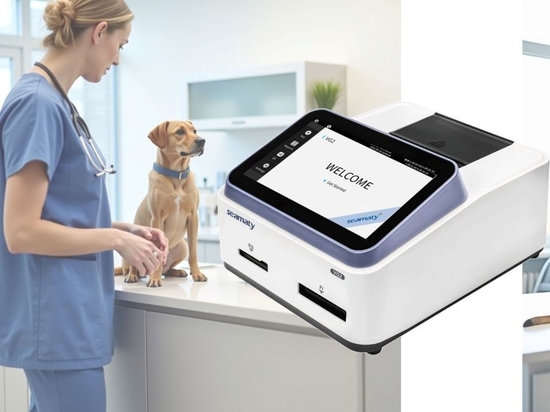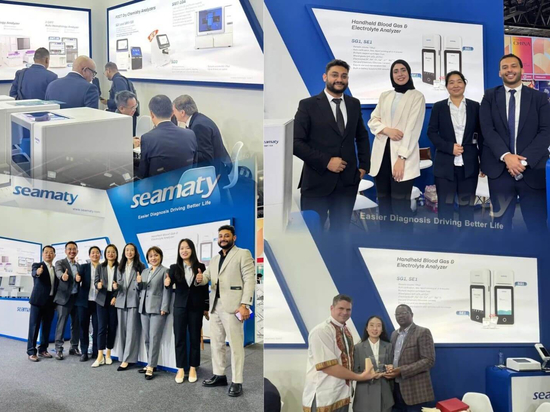
#Industry News
Dry vs. Wet: Unraveling the Battle of Chemistry Analyzers
Seamaty SD1
Chemistry analyzers play a pivotal role in clinical diagnostics, enabling healthcare practitioners to obtain crucial information about a patient's health. Two prominent types of analyzers, dry chemistry and wet chemistry, have revolutionized the field. In this article, we will delve into the differences between these two technologies, explore their advantages and disadvantages, and shed light on the innovative dry chemistry analyzers offered by Seamaty.
I. Wet Chemistry Analyzers
Wet chemistry analyzers have long been the gold standard in clinical diagnostics. These analyzers employ traditional methodologies that involve liquid reagents and extensive sample preparation. While they have proven effective, they do come with certain limitations. Wet chemistry analyzers require skilled operators, extensive time for sample preparation, and a significant amount of reagents.
II. Dry Chemistry Analyzers
Enter dry chemistry analyzers, a technology that has revolutionized clinical diagnostics. Dry chemistry analyzers offer a more efficient and convenient approach to testing. Seamaty's dry chemistry analyzers, in particular, have garnered attention for their innovative features and capabilities. Let's explore some of the advantages of dry chemistry analyzers as well as the unique offerings of Seamaty's products.
III. Comparison of Dry and Wet Chemistry Analyzers
①Methodology: Dry chemistry analyzers utilize a dry reagent system, eliminating the need for sample preparation and liquid reagents. In contrast, wet chemistry analyzers require careful sample handling and involve liquid reagents that need to be precisely measured and mixed.
②Accuracy: Both dry and wet chemistry analyzers offer accurate results. However, dry chemistry analyzers, including Seamaty's products, have made significant advancements in precision, ensuring reliable test outcomes.
③Turnaround Time: Dry chemistry analyzers excel in speed, providing results in a fraction of the time required by wet chemistry analyzers. Seamaty's dry chemistry analyzers, such as the SMT-120, deliver accurate results within just 12 minutes, enabling faster decision-making and improved patient care.
④Cost-effectiveness: Dry chemistry analyzers require fewer consumables, such as reagents, reducing overall costs. Seamaty's SMT-120, designed for small and medium-sized laboratories, offers a cost-effective solution by utilizing patented single-use reagent discs that contain up to 18 chemistry tests.
⑤User-friendliness: Dry chemistry analyzers are designed with user convenience in mind. Seamaty's SD1 dry chemistry analyzer boasts a small size, easy operation, and built-in features such as a centrifuge and QR code system. These user-friendly aspects streamline laboratory workflows and enhance efficiency.
V. Seamaty's Dry Chemistry Analyzers
Seamaty SMT-120 Dry Chemistry Analyzer: The SMT-120 is a fully automated clinical chemistry system designed for on-site testing. It offers small laboratories a cost-effective solution with accurate results in just 12 minutes. The utilization of patented single-use reagent discs, capable of conducting up to 18 chemistry tests, ensures efficiency and convenience.
Seamaty SD1 Dry Chemistry Analyzer: The SD1 is a fully automated dry chemistry analyzer that enables faster, easier, and more accurate medical diagnosis using just 0.1cc of whole blood, serum, or plasma. Its cloud computing capabilities empower operators to make medical decisions remotely. With a built-in centrifuge, QR code system, and real-time quality control, the SD1 ensures reliable results printed automatically after 12 minutes.
Conclusion
Dry chemistry analyzers have brought about a paradigm shift in clinical diagnostics, challenging the dominance of traditional wet chemistry analyzers. The advantages of dry chemistry analyzers, such as speed, accuracy, cost-effectiveness, and user-friendliness, make them a compelling choice for modern laboratory settings. Seamaty's innovative dry chemistry analyzers, including the SMT-120 and SD1, further enhance the capabilities of these devices, offering efficient and accurate on-site testing solutions. By embracing these advancements, healthcare practitioners can improve patient care and streamline laboratory operations.






